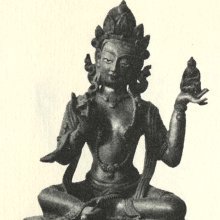Samantaprabha, Samantaprabhā, Samanta-prabha: 7 definitions
Introduction:
Samantaprabha means something in Buddhism, Pali, Hinduism, Sanskrit. If you want to know the exact meaning, history, etymology or English translation of this term then check out the descriptions on this page. Add your comment or reference to a book if you want to contribute to this summary article.
Images (photo gallery)
In Buddhism
Tibetan Buddhism (Vajrayana or tantric Buddhism)
Source: Wisdom Library: Tibetan BuddhismSamantaprabha (समन्तप्रभ) is the name of a Pratyekabuddha mentioned as attending the teachings in the 6th century Mañjuśrīmūlakalpa: one of the largest Kriyā Tantras devoted to Mañjuśrī (the Bodhisattva of wisdom) representing an encyclopedia of knowledge primarily concerned with ritualistic elements in Buddhism. The teachings in this text originate from Mañjuśrī and were taught to and by Buddha Śākyamuni in the presence of a large audience (including Samantaprabha).
Source: archive.org: The Indian Buddhist IconographySamantaprabhā (समन्तप्रभा) or Samantaprabhābhūmi refers to one of twelve Bhūmi Goddesses, as commonly depicted in Buddhist Iconography, and mentioned in the 11th-century Niṣpannayogāvalī of Mahāpaṇḍita Abhayākara.—Her Colour is red; her Symbol is an image of Amitābha; she has two arms.
Samantaprabhā is described in the Niṣpannayogāvalī (dharmadhātuvāgīśvara-maṇḍala) as follows:—
Source: MDPI Books: The Ocean of Heroes“Samantaprabhā is of the colour of the sun at noon, and holds in her left hand the image of Amitābha Buddha which indicates Perfect Enlightenment”.
[These twelve bhūmis [viz., Samantaprabhā] are two-armed and hold in the right hand the vajra and in the left their own weapons or signs.]
Samantaprabhā (समन्तप्रभा) refers to the “universal splendor”, according to the 10th-century Ḍākārṇava-tantra: one of the last Tibetan Tantric scriptures belonging to the Buddhist Saṃvara tradition consisting of 51 chapters.—Accordingly: [while explaining the speech circle (vākcakra)]: “[...] [Every] goddess on this circle inherently has the nature of wisdom and means They are taught in the Catuṣpīṭhatantra, consisting of 12,000 [stanzas]: [they are equivalent to] Jñānaḍākinī and others. [This is] the doctrine of the goddesses starting with Pūjā. [This circle is declared] to be the pīlava (“village border”) site: In this way, [the goddesses are of] the Universal Splendor Level (samantaprabhā-bhūmi) [ityevaṃbhūmiśca samantaprabhā]. [...]”

Tibetan Buddhism includes schools such as Nyingma, Kadampa, Kagyu and Gelug. Their primary canon of literature is divided in two broad categories: The Kangyur, which consists of Buddha’s words, and the Tengyur, which includes commentaries from various sources. Esotericism and tantra techniques (vajrayāna) are collected indepently.
General definition (in Buddhism)
Source: Wisdom Library: Dharma-samgrahaSamantaprabhā (समन्तप्रभा) refers to “all-round light” and represents the eleventh of the “thirteen stages of the Bodhisattva” (bhūmi) as defined in the Dharma-saṃgraha (section 65). The Dharma-samgraha (Dharmasangraha) is an extensive glossary of Buddhist technical terms in Sanskrit (e.g., samantaprabhā). The work is attributed to Nagarjuna who lived around the 2nd century A.D.
Languages of India and abroad
Sanskrit dictionary
Source: Cologne Digital Sanskrit Dictionaries: Edgerton Buddhist Hybrid Sanskrit DictionarySamantaprabha (समन्तप्रभ).—(1) name of a Buddha: Gaṇḍavyūha 284.11, and see s.v. Samantaprabhāsa; (2) name of a Bodhisattva: [Page563-a+ 71] Mahāvyutpatti 707; Rāṣṭrapālaparipṛcchā 1.12; (3) m., a kind of flower: Mahāvyutpatti 6191.
--- OR ---
Samantaprabhā (समन्तप्रभा).—name of an eleventh (Bodhisattva-) bhūmi, one of three added to the usual ten, according to Dhar- mas 65.
Source: Cologne Digital Sanskrit Dictionaries: Monier-Williams Sanskrit-English Dictionary1) Samantaprabha (समन्तप्रभ):—[=sam-anta-prabha] [from sam-anta] m. a kind of flower, [cf. Lexicographers, esp. such as amarasiṃha, halāyudha, hemacandra, etc.]
2) [v.s. ...] Name of a Bodhisattva, [Buddhist literature]
[Sanskrit to German]
Sanskrit, also spelled संस्कृतम् (saṃskṛtam), is an ancient language of India commonly seen as the grandmother of the Indo-European language family (even English!). Closely allied with Prakrit and Pali, Sanskrit is more exhaustive in both grammar and terms and has the most extensive collection of literature in the world, greatly surpassing its sister-languages Greek and Latin.
See also (Relevant definitions)
Partial matches: Prabha, Samanta.
Starts with: Samantaprabhabhumi, Samantaprabhasa, Samantaprabhashritejas, Samantaprabhatejas.
Ends with: Lakshanasuryacakrasamantaprabha, Lakshanasuryachakrasamantaprabha.
Full-text: Samantaprabhabhumi, Samantaprabhasa, Dvadashabhumi, Bhumi.
Relevant text
Search found 5 books and stories containing Samantaprabha, Samantaprabhā, Samanta-prabha, Samanta-prabhā; (plurals include: Samantaprabhas, Samantaprabhās, prabhas, prabhās). You can also click to the full overview containing English textual excerpts. Below are direct links for the most relevant articles:
The Sutra of Queen Śrīmālā of the Lion’s Roar
Blue Annals (deb-ther sngon-po) (by George N. Roerich)
Chapter 2 - The genealogy of Mahāsammata < [Book 1 - The beginning of the story of the Doctrine]
The Great Chariot (by Longchenpa)
Part 3e.2a - The self-existing nirmanakaya < [B. The explanation of the kayas and wisdoms]
Guhyagarbha Tantra (with Commentary) (by Gyurme Dorje)
Text 3.5 (Commentary) < [Chapter 3 (text and commentary)]
Text 13.8 (Commentary) < [Chapter 13 (Text and Commentary)]

